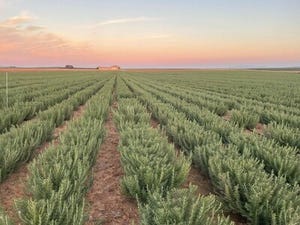USDA issues long-term crop forecasts

U.S. corn production is projected to drop to a little more than 14 billion bu. in 2017 and is not expected to reach 15 billion bu. again until after 2026, while soybean production will slip to 4.05 billion bu. next year and hover just above 4 billion bu. for the next several years, according to the U.S. Department of Agriculture's long-term projections released in late November (Table).
While the numbers are interesting to look at, they are not critical for fine-tuning future balance sheets. The projections are statistical assumptions and are not based on farmer surveys. They are created each year to estimate farm program spending.
The 2017 statistics may be a little closer to reality because of current acreage and market forces, but after that, the numbers become less significant.
For the 2017-18 crop year, the USDA projections show a U.S. corn crop of 14.06 billion bu. and a soybean crop of 4.05 billion bu., both of which are down from estimates for the just-completed harvests of 15.226 billion bu. for corn and 4.36 billion bu. for beans.
Planted corn acreage is expected to decrease to 90 million acres in 2017 and then hover at or below that for the next few years versus 94.5 million acres in 2016.
For soybeans, USDA has next year's planted acreage at 85.5 million versus this year's 83.7 million acres and then expects it to range from 84.5 million to 85.0 million acres for the next few years.
"USDA may well be too low on its soybean acreage forecast, but it is also likely too low on demand, which will even things out," Bryce Knorr, Farm Futures senior grain analyst, suggested.
"The corn number is below where our (Farm Futures) survey was at last summer by 3.1 million acres, but a lot has changed since then," Knorr said. "Farmers have had a way of planting more corn than anyone thinks possible (or wise), so the trade is looking at the 90 million number with jaundiced eyes right now. The agency said carryout would fall to 2.298 billion bu., close to the 2.260 billion we included in our latest 'Weekly Corn Review.'"
For soybeans, the carryout would drop to 396 million bu. next year from this year's 480 million bu. and would bottom out at 291 million bu. in the 2020-21 crop year before trending higher.
The projections put the average annual corn price at $3.30-3.35/bu. for the next several years before climbing to $3.70 in 2026. For soybeans, the price range would be $9.35-9.40/bu. for the next few years and would reach $9.55 in 2026.
For this report, USDA assumed annualized U.S. gross domestic product growth of about 2.1% and annualized total disposable income growth of 4.3-4.5% until 2026. The agency assumed a U.S. population of nearly 327 million people in 2017 that would go to 349.4 million people in 2026, with global population growth of about 1% per year.
Southeast wheat
Wheat farmers in the dry Southeast received an early Christmas present when rain moved through the area in late November.
In addition to the rain, the storms raised flash-flood warnings and produced a few tornadoes. For farmers in the region, forecasts showed above-normal chances for rain through early December.
"We are getting some rain, even if it is in small doses. The small amounts of rain will benefit those that have waited to seed," a Mississippi farmer said in that state's crop report.
Until the rain arrived, drought held sway there. Winter wheat struggled to emerge and was in poor shape when it finally did. Because USDA has discontinued its weekly crop progress reports for the season, it may be next spring before the benefits the rain had on the wheat crop will be known.
The Southeast region is not a big wheat producer, but it nonetheless does produce some wheat, so any reduction would be noticed because the overall crop is getting smaller. Farmers have been converting wheat acres to other crops that bring higher cash prices.
USDA's long-term crop projections released in late November put planted wheat acreage at 48.5 million for the 2017 crop. That would be down 3.4% from this year and the lowest acreage in more than 40 years.
The latest National Drought Monitor that came out in early November showed extreme to exceptional drought in the Southeast, and longer-term forecasts indicated that dry conditions would continue into February.
Using the Drought Monitor data, USDA at the time said 25% of the total winter wheat area, 13% of the typical corn area and 18% of the soybean area were in drought. For wheat, most of that drought-affected area is comprised of soft red winter wheat, which last year accounted for about 16% of the country's total wheat crop, or 372 million bu.
The season's final USDA weekly crop condition report rated the total U.S. winter wheat crop at 11% excellent, 47% good, 32% fair, 8% poor and 2% very poor, which compares to year-ago crop ratings of 11%, 44%, 36%, 7% and 2%, respectively.
Studies have shown that drought conditions are more likely to occur during a La Nina event than during El Nino. La Nina is in place now and is expected to continue through the winter. La Nina is the cooling of sea surface waters in the equatorial Pacific Ocean.
Although not currently experiencing drought, dry conditions also have created concerns for winter wheat in Colorado, western Kansas, Oklahoma and Nebraska. The hard red winter wheat in those states accounted for about a third of total 2016 production.
USDA survey time
USDA's National Agricultural Statistics Service will conduct its annual crop and livestock surveys during the first two weeks of December, the agency said.
Approximately 90,000 U.S. producers will be surveyed, making it one of USDA's largest survey efforts. The responses will provide the final information about the 2016 U.S. row crops, focusing on harvested acreage, production and storage.
The survey also will help establish county-level estimates used by the Farm Service Agency for the Agriculture Risk Coverage program and by the Risk Management Agency to administer insurance programs.
In addition, hog producers will be asked about their current inventory, the pig crop and farrowing intentions for the next six months.
With data collection and data release both taking place over a span of only four weeks, the results will be available beginning with the "Hogs & Pigs" report on Dec. 23, followed by the "Annual Crop Production Summary" and other reports on Jan. 12, 2017. County-level row crop estimates will be released later in 2017.
U.S. long-term projections for corn and soybeans |
|
Corn |
Planted area (mil. acres) |
Harvested area (mil. acres) |
Yield (bu./acre) |
Production (mil. bu.) |
Farm price ($/bu.) |
Soybeans |
Planted area (mil. acres) |
Harvested area (mil. acres) |
Yield (bu./acre) |
Production (mil. bu.) |
Farm price ($/bu.) |
Source: U.S. Department of Agriculture. |
Volume:88 Issue:12
About the Author(s)
You May Also Like



